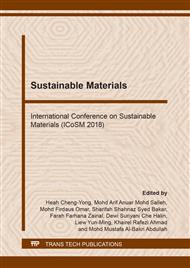[1]
Bagheri, R., Marouf, B. T., & Pearson, R. A. (2009). Rubber-Toughened Epoxies: A Critical Review. Polymer Reviews, 49(3), 201–225.
DOI: 10.1080/15583720903048227
Google Scholar
[2]
Ratna, D., & Banthia, A. K. (2004). Rubber toughened epoxy. Macromolecular Research, 12(1), 11–21.
DOI: 10.1007/bf03218989
Google Scholar
[3]
Ben Saleh, A. B., Mohd Ishak, Z.A., Hashim, A.S., & Kamil, W. A. (2009).
Google Scholar
[4]
Saenz, E. E., Carlsson, L. A., & Karlsson, A. M. (2011). In situ analysis of crack propagation in polymer foams. Journal of Materials Science, 46(16), 5487– 5494.
DOI: 10.1007/s10853-011-5491-y
Google Scholar
[5]
Avalle, M., Belingardi, G., & Montanini, R. (2001). Characterization of polymeric structural foams under compressive impact loading by means of energy- absorption diagram. International Journal of Impact Engineering, 25(5), 455–472.
DOI: 10.1016/s0734-743x(00)00060-9
Google Scholar
[6]
Fauzi, M. S., Lan, D. N. U., Osman, H., & Ghani, S. A. (2015). Effect of sodium bicarbonate as blowing agent on production of epoxy shape memory foam using aqueous processing method. Sains Malaysiana, 44(6), 869–874.
DOI: 10.17576/jsm-2015-4406-13
Google Scholar
[7]
Najib, N. N., Ariff, Z. M., Manan, N. A, Bakar, A A, & Sipaut, C. S. (2009). Effect of Blowing Agent Concentration on Cell Morphology and Impact Properties of Natural Rubber Foam. Journal of Physical Science, 20(1), 13–25.
Google Scholar
[8]
Lee, S. M., Han, J. H., Kim, K. Y., Ahn, Y. J., & Lee, J. W. (2010). High-pressure rheology of polymer melts containing supercritical carbon dioxide. Korea-Australia Rheology Journal 18(2), 83–90.
Google Scholar
[9]
Dworakowska, S., Cornille, A., Bogdal, D., Boutevin, B., & Caillol, S. (2015). Formulation of bio-based epoxy foams from epoxidized cardanol and vegetable oil amine. European Journal of Lipid Science and Technology, 117(11), 1893–(1902).
DOI: 10.1002/ejlt.201500232
Google Scholar
[10]
Hadi, A., Baghshahi S., Emadi, R. & Naghavi, S 2011. Different pore size alumina foams and study of their physical and mechanical properties, processings of the 2011 IAJC-ASEE. International Conference. Paper 132.
Google Scholar
[11]
Wan Hamad, W.N.F., Teh, P.L., & Yeoh, C. K. (2013). Effect of Acetic Acid Catalyst on the Properties of Epoxy Foam. Polymer-Plastics Technology and Engineering, 52(8), 754–760.
DOI: 10.1080/03602559.2012.762375
Google Scholar
[12]
Ishak, S.N., Teh, P.L., Lan, U., Ngoc, D., & Yeoh, C. K. (2016). Porous Epoxy: Effect of Mixing Sequences (ELH versus EHL) Using Toluene as Extraction Medium via Ultrasonic Technique. International Journal of Polymer Science, 2016, 2–7.
DOI: 10.1155/2016/4385626
Google Scholar


